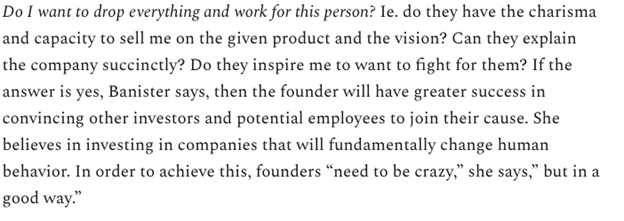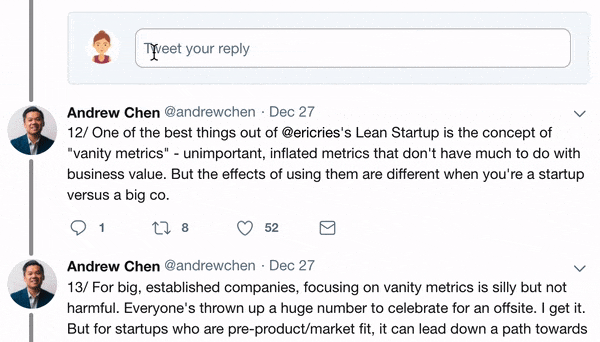
1/ When Cyan Banister writes a check, other investors pay attention. Her track record with Uber, SpaceX, Niantic, Postmates (and many more) speaks for itself—and the industry knows it. Her support can make a round.
So, what are the DOs and DON’Ts of pitching Cyan?
So, what are the DOs and DON’Ts of pitching Cyan?
2/ DO make sure you’re the right fit. Founders must be genuinely passionate about solving the problem they’re tackling—so if you’re just in it for the money, you should probably go elsewhere.
As she told fellow early Uber investor Jason Calacanis on his podcast:
As she told fellow early Uber investor Jason Calacanis on his podcast:

3/ DO be ready to talk about yourself.
Instead of wasting the time before a pitch meeting on small talk, Cyan likes to ask founders about themselves. She looks for founders who have faced adversity of some kind—even better if that experience connects you to your chosen problem.
Instead of wasting the time before a pitch meeting on small talk, Cyan likes to ask founders about themselves. She looks for founders who have faced adversity of some kind—even better if that experience connects you to your chosen problem.
4/ Cyan knows firsthand how hardship can shape a person’s life, instilling resilience and work ethic.
When she was 14, she became homeless after her mom abandoned her with $20 and a note reading “good luck.”
When she was 14, she became homeless after her mom abandoned her with $20 and a note reading “good luck.”
5/ DO consider how your personality makes you a good fit for the market problem you’re solving.
She lives by the founder-market fit doctrine. Her Uber investment is a prime example. When she first met Travis Kalanick, she thought:
She lives by the founder-market fit doctrine. Her Uber investment is a prime example. When she first met Travis Kalanick, she thought:

6/ Later, when she heard him pitch Uber, her research on the taxi industry told her that he would be the ideal fit. 

7/ DO be ready for her to move quickly if she likes the opportunity. She says you can determine if founders are the right ones to back in under an hour.
After she heard TK pitch Uber, she pulled the trigger without hesitation.
After she heard TK pitch Uber, she pulled the trigger without hesitation.

8/ Cyan decided to invest in Carta/eShares, when they were still onstage pitching the company.
https://twitter.com/cyantist/status/1078406753082109957
9/ If you’re a co-founding team, DO be prepared to answer questions about your relationship.
HQ Trivia, one of her former portcos, was torn apart by founder conflict. She now asks every team to explain how long they’ve known each other and how they resolve conflicts.
HQ Trivia, one of her former portcos, was torn apart by founder conflict. She now asks every team to explain how long they’ve known each other and how they resolve conflicts.
10/ DO explain how your product will fundamentally change behaviors. From Uber changing how people get around cities—and allow many to live without cars—to Postmates changing how users spend their evenings, she’s looking for companies that change the way people live their lives.
12/ DO bring Cyan opportunities that decentralize industries or break down barriers to entry.
https://twitter.com/cyantist/status/1233890179066167296
13/ DON’T pitch yourself as a diversity investment. Cyan loves diverse life experiences, but she doesn’t love seeing that “weaponized.” 

14/ DON’T rely on your educational or professional credentials to get you a deal.
Cyan—a high school dropout who has achieved extraordinary success—thinks the industry over-indexes these metrics.
Cyan—a high school dropout who has achieved extraordinary success—thinks the industry over-indexes these metrics.

15/ DON’T be boring.
Cyan’s number one test is: do I want to drop everything to work for this person?
(See Niantic's @johnhanke for someone she desperately wants to drop everything for)
Cyan’s number one test is: do I want to drop everything to work for this person?
(See Niantic's @johnhanke for someone she desperately wants to drop everything for)

End/ With Long Journey VC officially launching yesterday, there’s never been a better time to pitch @cyantist.
If you want to learn more about who this incredible investor is, how she got to where she is, and what she looks for, DO read this profile :)
cloudvalley.substack.com/p/cyan
If you want to learn more about who this incredible investor is, how she got to where she is, and what she looks for, DO read this profile :)
cloudvalley.substack.com/p/cyan
• • •
Missing some Tweet in this thread? You can try to
force a refresh








